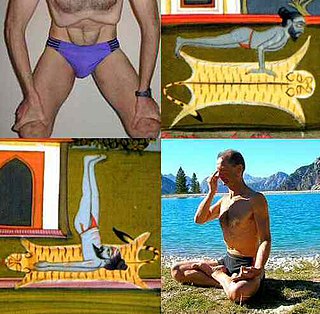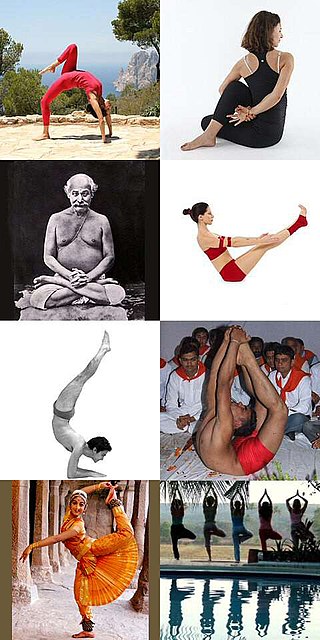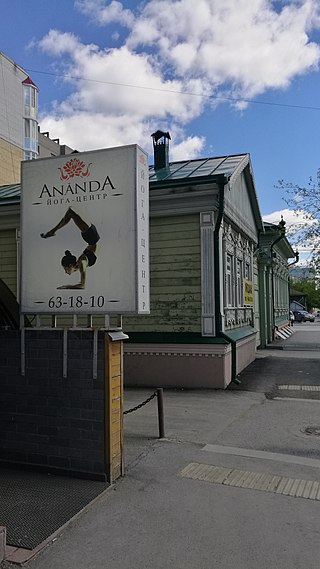
Paramahansa Yogananda was an Indian Hindu monk, yogi and guru who introduced millions to meditation and Kriya Yoga through his organization, Self-Realization Fellowship (SRF) / Yogoda Satsanga Society (YSS) of India – the only one he created to disseminate his teachings. A chief disciple of the yoga guru Swami Sri Yukteswar Giri, he was sent by his lineage to spread the teachings of yoga to the West. He immigrated to America at the age of 27 to prove the unity between Eastern and Western religions and to preach a balance between Western material growth and Indian spirituality. His long-standing influence in the American yoga movement, and especially the yoga culture of Los Angeles, led him to be considered by yoga experts as the "Father of Yoga in the West". He lived his last 32 years in America.
Bilocation, or sometimes multilocation, is an alleged psychic or miraculous ability wherein an individual or object is located in two distinct places at the same time. Reports of bilocational phenomena have been made in a wide variety of historical and religious contexts, ranging from ancient Greek legends and Christian traditions to modern occultism.

Hatha yoga is a branch of yoga that uses physical techniques to try to preserve and channel vital force or energy. The Sanskrit word हठ haṭha literally means "force", alluding to a system of physical techniques. Some hatha yoga style techniques can be traced back at least to the 1st-century CE, in texts such as the Hindu Sanskrit epics and Buddhism's Pali canon. The oldest dated text so far found to describe hatha yoga, the 11th-century Amṛtasiddhi, comes from a tantric Buddhist milieu. The oldest texts to use the terminology of hatha are also Vajrayana Buddhist. Hindu hatha yoga texts appear from the 11th century onward.

Sri Yukteswar Giri is the monastic name of Priya Nath Karar, an Indian monk and yogi, and the guru of Paramahansa Yogananda and Swami Satyananda Giri. Born in Serampore, West Bengal, Sri Yukteswar was a Kriya yogi, a Jyotisha, a scholar of the Bhagavad Gita and the Upanishads, an educator, author, and astronomer. He was a disciple of Lahiri Mahasaya of Varanasi and a member of the Giri branch of the Swami order. As a guru, he had two ashrams, one in Serampore and another in Puri, Odisha, between which he alternated his residence throughout the year as he trained disciples.

Self-Realization Fellowship (SRF) is a worldwide, spiritual organization founded by Paramahansa Yogananda in 1920. Before coming to the United States, Yogananda began his spiritual work in India in 1917 and named it Yogoda Satsanga Society of India (YSS). He founded SRF in 1920 and in 1925 the Mount Washington property became the international headquarters for SRF and YSS, located in Los Angeles, California. Before his return visit to India in 1935, he legally incorporated SRF in the United States as a non-profit religious organization. He only created SRF as the organization to carry on his work - to care for and disseminate his teachings.

Bellur Krishnamachar Sundararaja Iyengar was an Indian teacher of yoga and author. He is founder of the style of yoga as exercise, known as "Iyengar Yoga", and was considered one of the foremost yoga gurus in the world. He was the author of many books on yoga practice and philosophy including Light on Yoga, Light on Pranayama, Light on the Yoga Sutras of Patanjali, and Light on Life. Iyengar was one of the earliest students of Tirumalai Krishnamacharya, who is often referred to as "the father of modern yoga". He has been credited with popularizing yoga, first in India and then around the world.

An āsana is a body posture, originally and still a general term for a sitting meditation pose, and later extended in hatha yoga and modern yoga as exercise, to any type of position, adding reclining, standing, inverted, twisting, and balancing poses. The Yoga Sutras of Patanjali define "asana" as "[a position that] is steady and comfortable". Patanjali mentions the ability to sit for extended periods as one of the eight limbs of his system. Asanas are also called yoga poses or yoga postures in English.

The Yoga Sutras of Patañjali is a collection of Sanskrit sutras (aphorisms) on the theory and practice of yoga – 195 sutras and 196 sutras. The Yoga Sutras was compiled in the early centuries CE, by the sage Patanjali in India who synthesized and organized knowledge about yoga from much older traditions.

Pranayama is the yogic practice of focusing on breath. In yoga, breath is associated with prana, thus, pranayama is a means to elevate the prana-shakti, or life energies. Pranayama is described in Hindu texts such as the Bhagavad Gita and the Yoga Sutras of Patanjali. Later in Hatha yoga texts, it meant the complete suspension of breathing. The pranayama practices in modern yoga as exercise are unlike those of the Hatha yoga tradition.

Levitation or transvection, in the paranormal or religious context, is the claimed ability to raise a human body or other object into the air by mystical means.

Kriya Yoga is a yoga system which consists of a number of levels of pranayama, mantra, and mudra, intended to rapidly accelerate spiritual development and engender a profound state of tranquility and God-communion. It is described by its practitioners as an ancient yoga system revived in modern times by Lahiri Mahasaya, who claimed to be initiated by a guru, Mahavatar Babaji, circa 1861 in the Himalayas. Kriya Yoga was brought to international awareness by Paramahansa Yogananda's book Autobiography of a Yogi and through Yogananda's introductions of the practice to the West from 1920.

Autobiography of a Yogi is an autobiography of Paramahansa Yogananda published in 1946.

Rajarsi Janakananda, born James Jesse Lynn was the leading disciple of the yogi Paramahansa Yogananda and a prominent businessman in the Kansas City, Missouri area. A self-made millionaire when he met Yogananda in 1932, he later left a total endowment of approximately six million dollars to Yogananda's organization, Self-Realization Fellowship(SRF)/Yogoda Satsanga Society of India(YSS), helping ensure its long-term success. Yogananda also chose Janakananda to succeed him as president of SRF/YSS. Janakananda was second president of SRF/YSS from 1952 until 1955.

Pranava yoga is meditation on the sacred mantra Om, as outlined in the Upanishads, the Bhagavad Gita, and the Yoga Sutras of Patanjali. It is also called Aum yoga and Aum yoga meditation. It is, simply put, fixing the mind on the sound of the mantra "Aum" – the sacred syllable that both symbolizes and embodies Brahman, the Absolute Reality – as the mantra is constantly repeated in unison with the breath. The purpose of pranava yoga is to become free from suffering and limitation.

Raghavendra Swami of Malladihalli (1890–1996), popularly known as ತಿರುಕ Tiruka ("beggar"), was the founder of Anatha Sevashrama Trust, Malladihalli. He taught yoga from his base as Malladihalli near Holalkere in Chitradurga district, a village in Karnataka, India.
Integral Yoga is a system of yoga that claims to synthesize six branches of classical Yoga philosophy and practice: Hatha, Raja, Bhakti, Karma, Jnana, and Japa yoga. It was brought to the West by Swami Satchidananda, the first centre being founded in 1966. Its aim is to integrate body, mind, and spirit, using physical practices and philosophical approaches to life to develop the physical, emotional, intellectual, and spiritual aspects of individuals. The system includes the practices of asana, pranayama, and meditation to develop physical and mental stillness so as to access inner peace and joy, which Satchidananda believed was a person's true nature. It also encourages practitioners to live service-oriented lives.

Yoga Makaranda, meaning "Essence of Yoga", is a 1934 book on hatha yoga by the influential pioneer of yoga as exercise, Tirumalai Krishnamacharya. Most of the text is a description of 42 asanas accompanied by 95 photographs of Krishnamacharya and his students executing the poses. There is a brief account of practices other than asanas, which form just one of the eight limbs of classical yoga, that Krishnamacharya "did not instruct his students to practice".

Ashtanga yoga is Patanjali's classification of classical yoga, as set out in his Yoga Sutras. He defined the eight limbs as yamas (abstinences), niyama (observances), asana (posture), pranayama (breathing), pratyahara (withdrawal), dharana (concentration), dhyana (meditation) and samadhi (absorption).

Yoga has been practised in Russia since the actor Constantin Stanislavski made extensive use of Hatha Yoga in his system for training actors in the 1910s.
The Dattātreyayogaśāstra, a Vaisnava text probably composed in the 13th century CE, is the earliest text which provides a systematized form of Haṭha yoga under that name, and the earliest to place its yoga techniques under the name Haṭha.
















